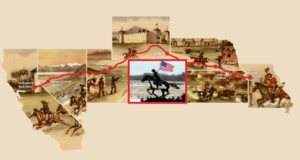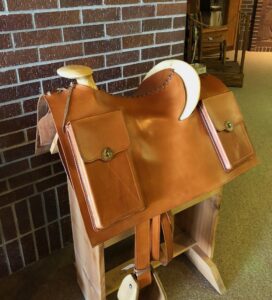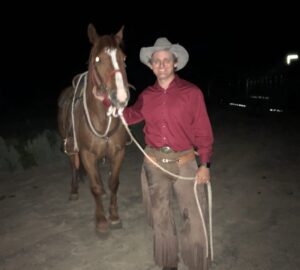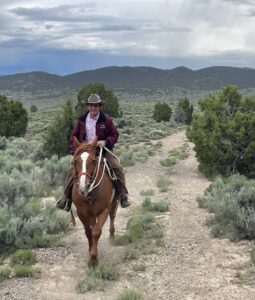Remember the Pony Express?
Our guest columnist didn’t just want to remember the short-lived, speedy letter delivery route. He wanted to experience it. And we’re lucky to read about it!
Curtis Moore grew up in Bishop, California, where he spent his summers packing mules in the Eastern Sierra. During college, he cowboyed at a ranch near Greenfield, California, where he learned and practiced low pressure stockmanship techniques. In law school, he focused on environmental and natural resource law, subjects that would lead him to simultaneously pursue a master’s in conflict and dispute resolution from the University of Oregon.
Since graduating, he has worked as a law clerk in Ely, Nevada, a deputy district attorney in Elko, Nevada, and an adjunct political science instructor at Great Basin College, before becoming Elko County’s Natural Resources Director. He has published articles on scientific mediation in natural resource conflicts.
In his spare time Curtis rides his horse, Rooster, writes, and makes memes about underrated fantasy novels.
By Curtis Moore

The Pony Express National Historic Trail starts in Missouri and extends through Kansas, Nebraska, Wyoming, Colorado, Utah, Nevada, and California.
Racing through a moonless desert night on a panicking mustang is one of the most authentic ways to experience the Pony Express Re-Ride, but it’s not the only way to do it. Every year, from Sacramento to St. Louis, dozens of volunteer riders station themselves along the old Pony Express Trail to deliver mail the old-fashioned way. This June was my first year participating, and it will certainly not be my last.
The Pony Express only lasted about a year and a half, but its legacy looms large along highway 50 in Nevada, where the original trail crosses and re-crosses the road. Today, much of the original trail in this state is accessible where it runs over public land. The original stations have deteriorated faster than the trail itself, although here and there bits of them remain. The route was designed for speed, and it alternates between twisting through low mountain ranges and shooting straight through alkali flats.

The mochila
Truth be told, I approached my first year of the Re-Ride with a whole chest full of unearned confidence. Travis Gerber, the Elko attorney who got me into this, had told me a little about it. Our team of about eight people would be assigned a forty mile stretch of trail, which would make each leg about five miles. We would swap the mochila at every stop, and by the early hours of the morning our part in this cross-country undertaking would be done.
I’ve written a little about my horse, Rooster, on NickerNews before. He’s very snorty, and he would like anyone who meets him to believe he’s still the wildest of mustangs despite his age and his fondness for molasses treats. He’s been with me since we were ranching near Monterey, California, and he’s as sure-footed a mountain horse I’ve ever had, and he’s never run out of energy. Five miles wouldn’t be a problem for him. Here ends the things I was right about.
The most glaring gap in my knowledge was, I assert, a language problem more than anything else. I took enough Spanish in college to know that mochila means a backpack or a bag. I didn’t think I’d be carrying a nylon Jansport, but I did assume it would be some kind of sack I could tie behind or in front of my own saddle. That was not the case. The Pony Express mochila is a large piece of leather with holes for the cantle and horn that goes over a western saddle, with pockets sewn onto it for the letters. Fully loaded it’s about fifty pounds. If I’d taken the time to look up what this thing was, I probably could have done some training on Rooster to get him ready for it. But I didn’t, and I don’t blame him for how he reacted.

Curtis and Rooster before ‘take off’
The mail reached my spot at 1:30 am, which is the first time Rooster or I got a look at this thing. The night was moonless, so the only light came from my headlamp and the headlights of the crew whose job it is to race along the roads and open the range gates for the riders. Rooster shied when we pulled it off Travis’ horse, and he was even more upset when I tried to put it on him. I figured out if I moved quickly enough and turned my light off, he wouldn’t know what I was doing until it was on there, and he might not figure it out until I was fully mounted.
I was right in that, but the whole thing was too much for Rooster and he took off. Like I said, galloping through the dark on a half-spooked mustang is probably the most authentic way to do this, and our race through the pinyon trees into Diamond Valley was one of the most fun things I’ve done in my entire life, but I don’t know if it’s the way I would recommend to anyone I liked.

The pair scouts the route earlier in the day.
We got to the end of our leg and I pulled the mochila off Rooster before he could think too hard about it. My legs were sore from where the extra leather chafed. My side had a stitch in it, and my face hurt from smiling that long. Rooster was ready to go another five miles, so we rode the next leg with my friend, Casey. If the wild ride alone was one of the funnest things I’ve done, riding it with a friend was one of the most fulfilling.
All this is to say I don’t think there’s any one way to enjoy the Re-Ride. If you’re interested in participating, check out the chapters here. My only advice is to bring snacks to share, get ready to make new friends, and try to at least Google mochila before you go.